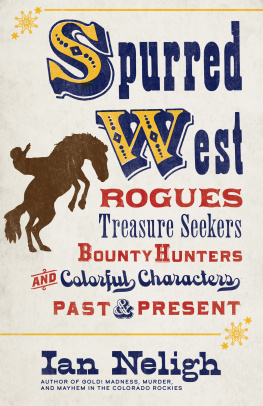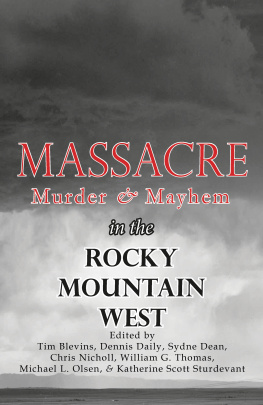
GOLD!
MADNESS, MURDER, AND MAYHEM IN THE COLORADO ROCKIES

IAN NELIGH

Text 2017 by Ian Paul Neligh
All rights reserved. No part of this book may be reproduced or transmitted in any form or by any means, electronic or mechanical, including photocopying, recording, or by any information storage and retrieval system, without written permission of the publisher.
Library of Congress Cataloging-in-Publication Data
Names: Neligh, Ian Paul, author.
Title: Gold! : madness, murder, and mayhem in the Colorado Rockies / Ian Paul Neligh.
Description: Portland, Oregon : WestWinds Press, an imprint of Graphic Arts Books, 2017. | Includes bibliographical references. |
Identifiers: LCCN 2017012535 (print) | LCCN 2017033907 (ebook) | ISBN 9781513260655 (paperback) | ISBN 9781513260679 (hardbound) | ISBN 9781513260662 (ebook)
Subjects: LCSH: ColoradoGold discoveriesHistory. | Gold minersRocky MountainsBiography. | Gold mines and miningRocky MountainsHistory.
Classification: LCC F776.6 (ebook) | LCC F776.6 .N45 2017 (print) | DDC 978.8/02dc23
LC record available at https://lccn.loc.gov/2017012535
Designed by Vicki Knapton
Cover Image Credits: skull: iStock.com/ianmcdonnell; background: wet2017/Shutterstock.com
Published by WestWinds Press
An imprint of

GraphicArtsBooks.com
Contents
For Billie, of course.
Introduction
G old! Clear as day and twice as bright, the glittering piece of metal winked up at me from the tide pool of black sand. Hardly daring to breathe, I adjusted my pan again and coaxed another little wave to further reveal the treasure. The dirt drew back, and my heart began beating faster. Mouth dry, I could hardly believe it. Id found an actual piece of Colorado gold.
It was the same gold that tempted the Spanish to venture into dangerous new lands hundreds of years ago. It was the same gold that inspired legend, provoked madmen, dreamers, and treasure hunters. It was the same gold, even when found in the smallest quantities, that set fire to a gold rush that swept across the United States in 1859 and drew to the Rockies a staggering 100,000 people. Towns formed, laws were cast, and a state was bornall because of the same gold that I now gazed down at.
As a newspaper reporter, Id spent years working in and around the towns and cities established in the desperate scramble for gold. Id worked in the brick buildings, walked the narrow streets, and seen the amber-colored stains running from forgotten mines like the aftermath of bullet holes from a gunfight.
Id looked at a bygone eras hulking relics, left to lean dangerously from the hillsides and valleys, rusted tributes to a time when a fortune could be dug from the ground and anyone, regardless of their economic status, could change it all in the blink of an eye. They also serve as memorials to crushed dreams, lives, and an environmental legacy that will chain us to the sites for all of time.
What I found more compelling were those that still hunted for their fortune in the shade cast by the gold rush more than 150 years ago. Prospectors, miners, and treasure hunters who ignored popular sentiment that the gold was gone, that it had disappeared or was too hard to remove. A small community engages in dangerous, backbreaking work even today to pry wealth from the dirt and rock of the Colorado mountains.
Fascinated with both the history of the gold rush and those who still toiled in its legacy, I spent a year meeting with them, hearing their stories, and trying to understand why it is they continue to do what they dooften in the face of extreme hardship. Many times by word of mouth, I went and met with one after the other and discovered the dubious inheritance of the gold rush included far more than just miners and prospectors.
But for the moment those thoughts were far away. Id found gold in a chilly Colorado stream, and that is, after all, how it all began.
 CHAPTER 1
CHAPTER 1
WOLVERINES AND SUNKEN TREASURE
D espite the bitter cold, George Jackson continued wading through waist-deep snow, going ever farther west into what would become the Colorado Rockies. Originally from Missouri, the hunter, trapper, and experienced prospector had no clear destination; Jackson just wanted to see what was beyond the next bend in the river. In retrospect this was maybe not the best idea as he had nearly drowned some weeks before and was saved by one of his traveling companions. But now Jackson was alone, save for his two dogs, and often risked injury or death. Even so, he continued west. It was the winter of 1859.
On January 2, Jackson woke to hear his two dogs growling in the frigid blue hue of early morning. Eyes open, he scanned his campsite. The nearby herd of bighorn sheep he had spotted the day before were now gone. Kit and Drum continued their low, intense warning, which created plumes in the biting air. Then he spotted it. The mountain lion was only twenty feet away. The difference between life and death on the frontier was sometimes as simple as attacking first.
[I] pulled my gun from under the blankets. Shot too quick; broke his shoulder, Jackson wrote in his diary. He fired again, the second gunshot report deafening in the mountain canyon. The lion dropped dead to the snow.
Clear high wind and very cold, Jackson later remarked of the day, adding he spent this time in camp building with tree branches a small shelter from the freezing temperatures. The next day he spotted another mountain lion creeping up on him, which he also shot dead.
On January 4, Jackson and his dogs followed the river, which would later be named Clear Creek, for five miles, then followed the north fork of the river for five more miles through the rugged, ankle-splintering country. This was a land that had been seen briefly by the Spanish some two hundred years before, but was known to Native American tribes such as the Utes and Cheyenne. Exhausted, Jackson returned to his camp after dark and discovered yet another surprise.
Mountain lion stole all of my meat in camp; no supper tonightdamn him.
Jackson didnt know it, but he would soon make a discovery at the confluence of two creeks that would send many thousands of settlers into this far-flung western portion of what was then the Kansas Territory. The call to fame and fortune would dwarf the size of the California gold rush, bringing in miners, merchants, entrepreneurs, criminalsand lead to the formation of a state, which today has some 5.5 million residents. In just one more day George Jackson would make a discovery so large, it would light the fuse that set off the Colorado gold rush.
Bottom of the Ocean
In a near-abandoned high school parking lot, just south of the historic city of Idaho Springs, sits a monument dedicated to George Jackson. A giant and unimaginative potato-shaped boulder rests on a pedestal, hidden to one side by a grove of small trees. A plaque fixed to its front reads:
On this spot was made the first discovery of gold in the Rocky Mountains by George A. Jackson January 7th, 1859 placed 1909.
Next page
















 CHAPTER 1
CHAPTER 1